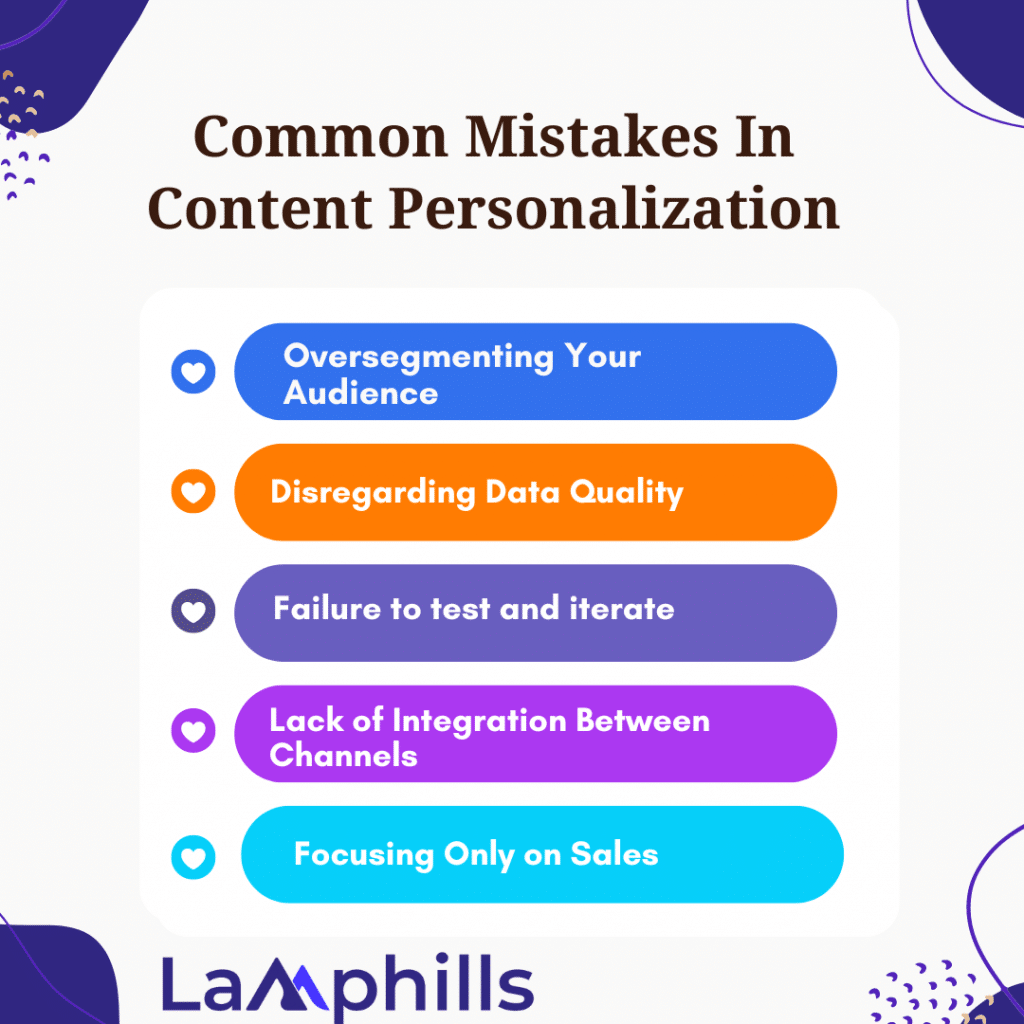Content personalization is one of today’s most popular digital marketing methods. It provides benefits such as improved user experience, increased engagement, and more revenue. But do you know what the primary challenges publishers and marketers face when attempting to use content personalization today? It wasn’t until I delved deeper that I learned I was making some of the most common content personalization mistakes, which many marketers ignore. In this post, I’ll go over these frequent problems and, more importantly, how to fix them.
Before we go into the mistakes, let’s define content personalization.
What is Content Personalization?
Content personalization is the process of adapting your content to your audience’s particular needs, tastes, and habits. When done effectively, it may greatly increase engagement, conversions, and client loyalty. However, attaining effective personalization is more difficult than it appears, and many experts, including myself, frequently fall into similar pitfalls.
Key Takeaways
- Focusing too much on creating numerous small audience segments can weaken efforts and inconsistent messaging.
- High-quality data is crucial for successful content personalization. Poor data can result in incorrect personalization, alienating your audience.
- Conduct A/B testing on your personalized content and use the insights gained to refine and improve your strategies continuously.
- Providing a seamless and consistent personalized experience across all touchpoints, including email, social media, and your website, is essential.
- Personalization should not only focus on driving sales but also on delivering value to your audience.
What are the Benefits of Content Personalization?
Content personalization benefits both businesses and users. Some of the primary benefits include:
#1. Improved user experience
Users find tailored content more relevant and entertaining, which enhances their entire experience. This can lead to better user loyalty and pleasure.
#2. Increased conversion rates
Businesses can boost conversion rates by tailoring content to users’ interests and preferences, users are more likely to take the intended action, like completing a purchase or signing up for a newsletter.
#3. Increased client retention
Offering personalized content allows businesses to enhance their connections with users, build long-term relationships, and boost the likelihood of repeat purchases.
#4. Higher engagement
Users are more likely to engage with tailored content, which can increase their time on the website and result in higher click-through rates and social media reactions.
#5. Better targeting and segmentation
Content personalization allows organizations to segment their consumers and provide focused messages, improving marketing effectiveness.
#6. Competitive advantage
Content personalization can set firms apart from competitors who offer generic, one-size-fits-all content. This can help firms that tailor content attract and retain customers.
#7. Improved data insights
The data collected and assessed during the personalization process can provide businesses with valuable insights into customer behavior and preferences, allowing for better product development and marketing strategy decisions.
However, it is critical to stress that content personalization should be done cautiously and responsibly, preserving user privacy and data security while avoiding unduly intrusive or deceptive tactics.
Types of Personalized Content
There are many examples of content personalization. Listed below are some of the most common:
#1. GPS-Based Applications
GPS-enabled apps may use the user’s location to deliver content tailored to their current location.
For example, if a user searches for “coffee shops near me” on Google Maps, the app will provide choices depending on their present location.
It is also feasible to use tailored data to tell clients about sales depending on their present location.
For example, suppose a retail chain has a sale in its Miami location. If the brand has a popular app, it can use location-based advertising to inform clients in the Miami region about the sale. To encourage nearby customers to visit the store.
However, only major corporations use this level of personalization because it is so sophisticated. Because it necessitates significant marketing dollars and experienced development teams.
#2. Interactive Content
Interactive content can help you collect information about individuals, which you can then utilize to build personalized experiences.
For example, a brand can use quizzes to learn about their clients’ preferences. Then utilize that information to make personalized product recommendations.
Jones Road, a beauty company, does this effectively. It asks questions about the user’s skin type, tone, and overall concerns.
And then sends them individualized makeup recommendations based on this information.
Polls, surveys, and calculators are examples of interactive content that use personalization to collect user input. It can then be utilized to provide tailored content.
#3. Landing Pages and Other Important Webpages
Potential buyers interact with your site most frequently on landing pages, home pages, and other high-value pages. As a result, they are ideal candidates for offering a tailored experience.
Take a peek at how Skratch Labs tailors their rewards center to users who log in.
And shows which products users can redeem (those with the clickable “Redeem Now” button highlighted in green) based on the number of points they have.
#4. Emails
Personalized emails allow you to communicate directly with the recipients, right in their inboxes.
While sending personalized emails to a large number of prospects and customers may appear daunting, automation features offered on most email marketing platforms make it a simple process.
Emails can be sent based on user activity, such as recent purchases, browsing history, or cart abandonment.
For instance, consider this personalized email from Harry and David:
It contains the recipient’s name in the subject line and even offers them a $25 discount.
#5. Retargeting Ads
Retargeting advertising is designed to re-engage clients who have previously expressed interest in your company. And it varies depending on what the user has looked at or interacted with.
For example, if a user views a car model on a website, they may receive advertisements for similar cars on social media.
Reminding the user of the product they searched for may encourage them to make a purchase.
Common Mistakes In Content Personalization and How To Fix Them

#1. Oversegmenting Your Audience
One of my initial mistakes was over-segmenting my target demographic. I believed that the more divisions I generated, the more tailored my content would be. However, this method frequently results in weakened efforts and inconsistent messaging. Instead of hyper-segmenting, concentrate on building broader segments that enable more robust data collection and an integrated content strategy.
How to Fix It: Begin by focusing on a few important segments that exhibit significant variances in your audience’s actions or preferences. Use data-driven insights to fine-tune these segments over time, ensuring that your content remains relevant and effective.
#2. Disregarding Data Quality
In my early days, I was so anxious to customize that I overlooked the quality of my data. Poor data quality might result in erroneous personalization, alienating your audience rather than engaging them. Make sure your data is correct, up-to-date, and thorough.
How to Fix It: Invest in dependable data sources and clean your data regularly. Use tools to validate and enrich your data to preserve its quality. In this manner, your personalization attempts will be founded on strong, trustworthy data.
#3. Failure to test and iterate
I figured that once I had integrated personalization, I could forget about it. This was a big oversight. Personalization is a continual process that involves constant testing and iteration to optimize.
How to Fix It: Conduct A/B testing on your personalized content and evaluate the results to determine what works best for your target audience. Use this information to continuously improve your personalization techniques.
#4. Lack of Integration Between Channels
Initially, I focused my personalization efforts on a single channel, resulting in a fragmented consumer experience. True personalization should give a consistent experience across all touchpoints, including email, social media, and your website.
How to Fix It: Implement integrated marketing solutions that enable you to deliver consistent and personalized experiences across numerous channels. Ensure that your messaging and data are in sync to deliver a seamless trip for your audience.
#5. Focusing Only on Sales
My early personalization efforts were primarily sales-oriented, which came across as forceful and disingenuous. Personalization should be about providing value to your audience rather than merely selling things.
How to Fix It: To balance your content personalization, provide value-driven content like educational resources, entertainment, or community-building activities. This method promotes trust and involvement, which can result in improved sales in the long run.
How To Incorporate Content Personalization Into Your Marketing Strategy
Adding content personalization to your marketing plan is a series of procedures that allow you to produce and deliver bespoke content to your target audience. Here is a possible approach:
#1. Define your goals
Identify the objectives of your marketing strategy, such as increasing customer retention, conversions, or engagement.
#2. Collect user data
Gather information about your target audience from a variety of sources, including website analytics, CRM data, social media engagements, and user surveys. Collect zero-party data that customers freely share with businesses to protect user privacy. The data you collect will help you understand your users’ preferences, activity, and demographics.
#3. Analyze data and create segments
Analyze the obtained data to identify patterns and trends. Divide users into segments based on common criteria such as demographics, interests, or habits. This allows you to change your marketing efforts more efficiently.
#4. Develop complete personas or profiles for each user category
Develop complete personas or profiles for each user category, including their interests, driving forces, and pain spots. These profiles will drive your content curation and development activities.
#5. Create and curate personalized content
Customize content for certain user segments or individuals depending on their choices, interests, and behaviors. You can produce targeted blog pieces, build personalized email campaigns, or provide personalized product suggestions.
#6. Use personalization technology
Personalization technology can be used to automate and simplify personalization processes. Examples include marketing automation tools, content management systems (CMS), and customer data platforms (CDP). These tools can help you deliver personalized content, offers, or experiences based on user data and behavior.
#7. Test and optimize
Monitor and assess the success of your tailored marketing initiatives. A/B testing, multivariate testing, and other methodologies can be used to determine what works best for each user segment or persona. Using these insights, you may improve and alter your personalization tactics.
#8. Ensure privacy and data security
To secure user information, follow data protection regulations, seek users’ consent before collecting their data, and implement strong data security measures.
By incorporating content personalization into your marketing plan, you can provide more relevant and interesting experiences to your users, resulting in increased engagement, satisfaction, and conversion rates.
Use Templates for Effective Personalization
To simplify your personalization efforts, consider employing templates that may be tailored to your audience segments. For example, a content personalization template can assist you in defining important messages, formats, and channels for various audience groups. This not only saves time but also guarantees that your content is consistent and relevant.
Ready to transform your e-commerce strategy with personalized content that truly resonates? Get started today and see how our solutions can help you achieve your business goals.
This template can be customized based on the specific needs and characteristics of your target audience, ensuring that your content is always relevant and engaging.
A customer onboarding email template can feature personalized greetings, tailored recommendations based on prior interactions, and dynamic content blocks that alter depending on the user’s activity. This template technique allows you to swiftly alter your messaging without having to start from scratch every time.
I recall launching a tailored email campaign to promote a new product. I thoroughly divided my target and created tailored communications. However, I failed to account for the integration of additional channels. As a result, the email campaign was effective, but the whole consumer experience was disconnected. This taught me the value of a comprehensive approach to personalization, ensuring that all channels operate flawlessly.
What are Content Personalization Tools?
Content personalization tools are software solutions that enable organizations to provide personalized content and experiences to their customers based on their preferences, habits, and other data points.
These tools automate the personalization process using algorithms, machine learning, or artificial intelligence, allowing enterprises to deploy and expand their personalization initiatives more easily. Some popular content personalization tools are:
#1. Braze
Braze is a comprehensive consumer engagement platform that enables conversations between customers and the businesses they love. It lets businesses process customer data, optimize appropriate cross-channel marketing efforts, and constantly increase client engagement, retention, and loyalty.
#2. MoEngage
MoEngage is an insights-driven consumer engagement platform that provides marketers and product owners with AI-powered insights to create omnichannel experiences. Businesses may use MoEngage to analyze consumer behavior and engage customers with personalized communication on the web, mobile, and via email
#3. CleverTap
CleverTap is a customer engagement and retention platform that enables organizations to create tailored experiences across several channels, including mobile, online, and email. Their smart, all-in-one platform brings together the greatest analytics, segmentation, and engagement tools to help businesses build lucrative, long-term relationships with their customers.
#4. Optimizely
Optimizely is a comprehensive experimentation and personalization tool that uses A/B testing, multivariate testing, and audience targeting to improve and personalize user experiences across web, mobile, and other digital channels.
#5. Adobe Target
As part of Adobe Experience Cloud, Adobe Target enables businesses to conduct A/B and multivariate testing, as well as apply AI-driven personalization, to optimize and adapt digital experiences for their customers.
#6. Evergage
Evergage (formerly Salesforce Interaction Studio) is a real-time personalization and interaction management platform that enables businesses to provide personalized content, offers, and suggestions based on user behavior and preferences.
Conclusion
Content personalization is an effective tool, but it is easy to make mistakes that can jeopardize your efforts. You may provide your audience with more relevant and effective personalized experiences by avoiding over-segmentation, guaranteeing data quality, regularly testing, integrating across channels, and balancing your content. Remember that personalization is a continuous technique that demands attention and flexibility.
Have you faced any difficulties with your content personalization efforts? Which tactics have worked best for you? Share your experiences and let’s learn from one another!
Related Articles
- What Is Authoritative Content? How It Is Used and Steps To Creating One
- Proven SaaS Content Marketing Tactics for Boosting Engagement and Conversions
- How to Create Promotional Content That Drives Results for Your Brand(Plus Examples)
- Branded Content Marketing: The Powerful Strategy Big Brands Don’t Want You to Know
- PERSONAL BRAND ATTRIBUTES: What They Are, How to Define Yours and Enhance Them




